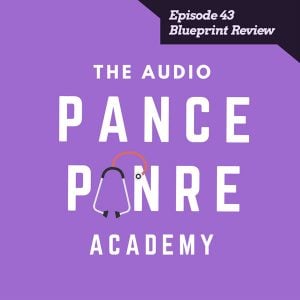Podcast: Play in new window | Download
Subscribe: Apple Podcasts | RSS
 Welcome to episode 43 of the FREE Audio PANCE and PANRE Physician Assistant Board Review Podcast.
Welcome to episode 43 of the FREE Audio PANCE and PANRE Physician Assistant Board Review Podcast.
Join me as I cover 10 PANCE and PANRE board review questions from the Academy course content following the NCCPA™ content blueprint (download the FREE cheat sheet).
This week we will continue to take a break from topic specific board review and covering 10 general board review questions.
Below you will find an interactive exam to complement the podcast.
I hope you enjoy this free audio component to the examination portion of this site. The full genitourinary board review includes over 72 GU specific questions and is available to all members of the PANCE and PANRE Academy.
- You can download and listen to past FREE episodes here, on iTunes or Stitcher Radio.
- You can listen to the latest episode, take an interactive quiz and download your results below.
Listen Carefully Then Take The Quiz
If you can’t see the audio player click here to listen to the full episode.
Episode 43 PANCE and PANRE Podcast Quiz
1. A mother brings in her five-year-old boy for his school physical. She voices some concerns about his readiness for school, saying he seems to be socially immature. She has noticed he does not interact with other children well, and that when he plays with them, he has a tendency to “place them” and then run around them as if they were statues. He rarely cries when he is hurt, and he shrugs off any attempt to hug him. He has good attention to details, and will sit and draw the same geometric shapes over and over again, but does not seem interested in learning the alphabet. He avoids eye contact with anyone. Which of the following is the most likely diagnosis?
- Normal 5 year-old
- Social phobia
- Autism
- Avoidant personality
2. A 3-week-old male infant presents with recurrent regurgitation after feeding that has progressed to projectile vomiting in the last few days. The mother states that the child appears hungry all of the time. She denies any diarrhea in the child. Which of the following clinical findings is most likely?
- Bile-stained vomitus
- Hemoccult positive stools
- Olive-sized mass in the right upper abdomen
- Sausage-shaped mass in the upper-mid abdomen
3. A 65 year-old with COPD receiving their first pneumococcal polysaccharide PPSV23 vaccination should be revaccinated in
- 1 year
- 3 years
- 5 years
- Never
4. Which of the following therapies is recommended for a 13 month-old child with sickle cell disease?
- Folic acid and penicillin V
- Ferrous sulfate and penicillin V
- Folic acid and ferrous sulfate
- Folic acid, ferrous sulfate and penicillin V
5. A patient with severe COPD presents to the Emergency Department with a 3 day history of increasing shortness of breath with exertion and cough productive of purulent sputum. An arterial blood gas reveals a pH of 7.25, PaCO2 of 70 mmHg and PaO2 of 50 mmHg. He is started on albuterol nebulizer, nasal oxygen at 2 liters per minute, and an IV is started. After one hour of treatment, his arterial blood gas now reveals a pH of 7.15, PaCO2 100 mmHg and PaO2 of 70 mmHg. Which of the following is the most appropriate next step in his treatment?
A. Decrease the oxygen flow rate.
B. Administer oral corticosteroids.
C. Intubate the patient.
D. Administer salmeterol (Serevent)
6. A patient should be tested for tuberculosis prior to being treated with
A. etanercept (Enbrel).
B. cyclosporine (Neoral).
C. methotrexate (Rheumatrex).
D. prednisone (Deltasone).
7. Which of the following side effects is associated with long-term administration of phenytoin (Dilantin)?
A. Ataxia
B. Hypotension
C. Osteomalacia
D. Cardiac dysrhythmia
8. Hairy leukoplakia has the greatest prevalence of distribution on the
A. palate.
B. floor of the mouth.
C. lateral tongue.
D. gingiva.
9. 75 year-old male presents for a routine physical. Vitals are normal with no orthostatic changes. On physical examination, a fine cortical movement with repetitive rubbing of the tip of the thumb along the tips of the fingers is noted at rest. Which of the following is the most likely diagnosis?
A. Seizure disorder
B. Peripheral neuropathy
C. Shy-Drager syndrome
D. Parkinson's disease
10. A 45 year-old female presents to the emergency department with generalized, hot, erythema of the skin. Physical exam reveals an oral temperature of 102 degrees Fahrenheit, purulent conjunctivitis, and mucosal erosions. Her skin is painful and separates from the dermis with touch. Which of the following is the most likely cause for this condition?
A. Penicillin
B. Prednisolone
C. Aspirin
D. Hydrochlorothiazide (HCTZ)
Looking for all the podcast episodes?
This FREE series is limited to every other episode, you can download and enjoy the complete audio series by joining The PANCE and PANRE Exam Academy.
I will be releasing new episodes every few weeks. The Academy is discounted, so sign up now.
Resources From The Show
- CDC Guidelines for the pneumococcal vaccine
- Join the PANCE and PANRE Academy + Smarty PANCE
- My list of recommended PANCE and PANRE review books
- The PANCE and PANRE Blueprint Checklist
- The Smarty PANCE NCCPA Content Blueprint Website + The PA Life Academy
- USE CODE “PALIFE” TO GET 10% OFF THE RUTGERS PANCE AND PANRE REVIEW COURSE
This Podcast is also available on iTunes and Stitcher Radio for Android
- iTunes: The Audio PANCE AND PANRE Podcast iTunes
- Stitcher Radio: The Audio PANCE and PANRE Podcast Stitcher
